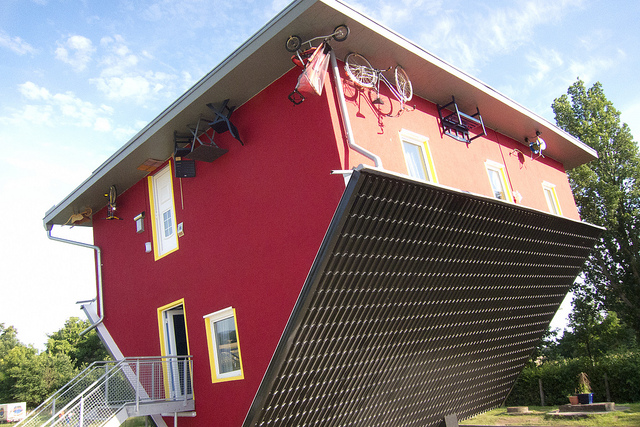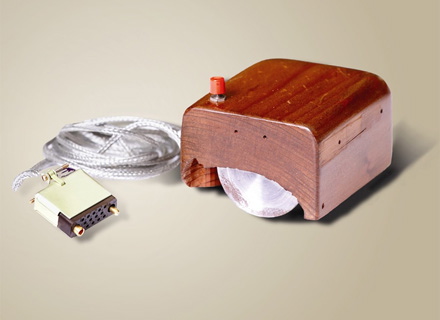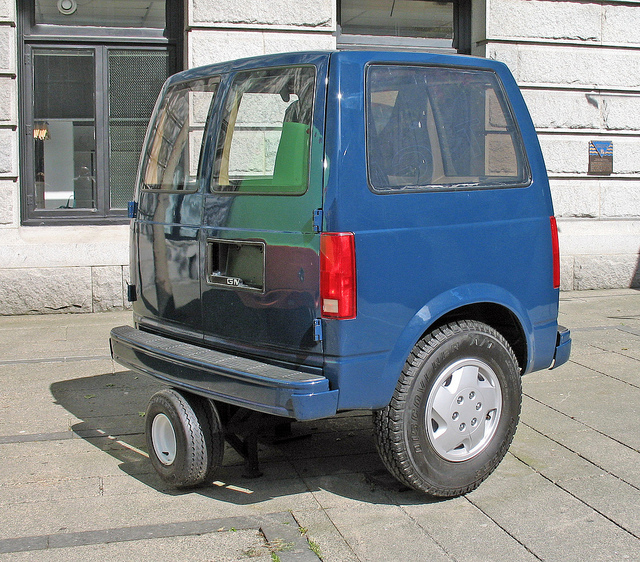Archive for the ‘Intellectual Intertia’ Category
Constructive Conflict
 Innovation starts with different, and when you propose something that’s different from the recipe responsible for success, innovation becomes the enemy of success. And because innovation and different are always joined at the hip, the conflict between success and innovation is always part of the equation. Nothing good can come from pretending the conflict does not exist, and it’s impossible to circumvent. The only way to deal with the conflict is to push through it.
Innovation starts with different, and when you propose something that’s different from the recipe responsible for success, innovation becomes the enemy of success. And because innovation and different are always joined at the hip, the conflict between success and innovation is always part of the equation. Nothing good can come from pretending the conflict does not exist, and it’s impossible to circumvent. The only way to deal with the conflict is to push through it.
Emotional energy is the forcing function that pushes through conflict, and the only people that can generate it are the people doing the work. As a leader, your job is to create and harness this invisible power, and for that, you need mechanisms.
To start, you must map innovation to “different”. The first trick is to ask for ideas that are different. Where brainstorming asks for quantity, firmly and formally discredit it and ask for ideas that are different. And the more different, the better. Jeffrey Baumgartner has it right with his Anticonventional Thinking (ACT) methodology where he pushes even further and asks for ideas that are anti-conventional.
The intent is to create emotional energy, and to do that there’s nothing better than telling the innovation team their ideas are far too conventional. When you dismiss their best ideas because they’re not different enough, you provide clear contrast between the ideas they created and the ones you want. And this contrast creates internal conflict between their best thinking and the thinking you want. This internal conflict generates the magical emotional energy needed to push through the conflict between innovation and success. In that way, you create intrinsic conflict to overpower the extrinsic conflict.
Because innovation is powered by emotional energy, conflict is the right word. Yes, it feels too strong and connotes quarrel and combat, but it’s the right word because it captures the much needed energy and intensity around the work. Just as when “opportunity” is used in place of “problem” and the urgency, importance, and emotion of the situation wanes, emotional energy is squandered when other words are used in place of “conflict”.
And it’s also the right word when it comes to solutions. Anti-conventional ideas demand anti-conventional solutions, both of which are powered by emotional energy. In the case of solutions, though, the emotional energy around “conflict” is used to overcome intellectual inertia.
Solving problems won’t get you mind-bending solutions, but breaking conflicts will. The idea is to use mechanisms and language to move from solving problems to breaking conflicts. Solving problems is regular work done as a matter of course and regular work creates regular solutions. But with innovation, regular solutions won’t cut it. We need irregular solutions that break from the worn tracks of predictable thinking. And do to this, all convention must be stripped away and all attachments broken to see and think differently. And, to jolt people out of their comfort zone, contrast must be clearly defined and purposefully amplified.
The best method I know to break intellectual inertia is ARIZ and algorithmic method for innovative solutions built on the foundation of TRIZ. With ARIZ, a functional model of the system is created using verb-noun pairs with the constraint that no industry jargon can be used. (Jargon links the mind to traditional thinking.) Then, for clarity, the functional model is then reduced to a conflict between two system elements and defined in time and place (the conflict domain.) The conflict is then made generic to create further distance from the familiar. From there the conflict is purposefully amplified to create a situation where one of the conflicting elements must be in two states at the same time (conflicting states) – hot and cold; large and small; stiff and flexible. The conflicting states make it impossible to rely on preexisting solutions (familiar thinking.) Though this short description of ARIZ doesn’t do it justice, it does make clear ARIZ’s intention – to use conflicts to break intellectual inertia.
Innovation butts heads and creates conflict with almost everything, but it’s not destructive conflict. Innovation has the best intentions and wants only to create constructive conflict that leads to continued success. Innovation knows your tired business model is almost out of gas and desperately wants to create its replacement, but it knows your successful business model and its tried-and-true thinking are deeply rooted in the organization. And innovation knows the roots are grounded in emotion and it’s not about pruning it’s about emotional uprooting.
Conflict is a powerful word, but the right word. Use the ACT mechanism to ask for ideas that constructively conflict with your success and use the ARIZ mechanism to ask for solutions that constructively conflict with your best thinking.
With innovation there is always conflict. You might as well make it constructive conflict and pull your organization into the future kicking and screaming.
Image credit – Kevin Thai
Battle Success With No-To-Yes
 Everyone says they want innovation, but they don’t – they want the results of innovation.
Everyone says they want innovation, but they don’t – they want the results of innovation.
Innovation is about bringing to life things that are novel, useful and successful. Novel and useful are nice, but successful pays the bills. Novel means new, and new means fear; useful means customers must find value in the newness we create, and that’s scary. No one likes fear, and, if possible, we’d skip novel and useful altogether, but we cannot. Success isn’t a thing in itself, success is a result of something, and that something is novelty and usefulness.
Companies want success and they want it with as little work and risk as possible, and they do that with a focus on efficiency – do more with less and stock price increases. With efficiency it’s all about getting more out of what you have – don’t buy new machines or tools, get more out of what you have. And to reduce risk it’s all about reducing newness – do more of what you did, and do it more efficiently. We’ve unnaturally mapped success with the same old tricks done in the same old way to do more of the same. And that’s a problem because, eventually, sameness runs out of gas.
Innovation starts with different, but past tense success locks us into future tense sameness. And that’s the rub with success – success breeds sameness and sameness blocks innovation. It’s a strange duality – success is the carrot for innovation and also its deterrent. To manage this strange duality, don’t limit success; limit how much it limits you.
The key to busting out of the shackles of your success is doing more things that are different, and the best way to do that is with no-to-yes.
If your product can’t do something then you change it so it can, that’s no-to-yes. By definition, no-to-yes creates novelty, creates new design space and provides the means to enter (or create) new markets. Here’s how to do it.
Scan all the products in your industry and identify the product that can operate with the smallest inputs. (For example, the cell phone that can run on the smallest battery.) Below this input level there are no products that can function – you’ve identified green field design space which you can have all to yourself. Now, use the industry-low input to create a design constraint. To do this, divide the input by two – this is the no-to-yes threshold. Before you do you the work, your product cannot operate with this small input (no), but after your hard work, it can (yes). By definition the new product will be novel.
Do the same thing for outputs. Scan all the products in your industry to find the smallest output. (For example, the automobile with the smallest engine.) Divide the output by two and this is your no-to-yes threshold. Before you design the new car it does not have an engine smaller than the threshold (no), and after the hard work, it does (yes). By definition, the new car will be novel.
A strange thing happens when inputs and outputs are reduced – it becomes clear existing technologies don’t cut it, and new, smaller, lower cost technologies become viable. The no-to-yes threshold (the constraint) breaks the shackles of success and guides thinking in a new directions.
Once the prototypes are built, the work shifts to finding a market the novel concept can satisfy. The good news is you’re armed with prototypes that do things nothing else can do, and the bad news is your existing customers won’t like the prototypes so you’ll have to seek out new customers. (And, really, that’s not so bad because those new customers are the early adopters of the new market you just created.)
No-to-yes thinking is powerful, and though I described how it’s used with products, it’s equally powerful for services, business models and systems.
If you want innovation (and its results), use no-to-yes thinking to find the limits and work outside them.
The Prerequisites for Greatness
 There are three prerequisites for greatness.
There are three prerequisites for greatness.
- You have to believe greatness is possible.
- You have to believe greatness is worth it.
- You have to believe you’re worthy of the journey.
If you can’t see old things in new ways, see new things in new ways, or see what’s missing, you won’t believe greatness is possible. To believe greatness is possible, you have to change your perspective.
Greatness is an uphill battle on all fronts, and to push through the pain requires weapons grade belief that it’s worth it. But the power isn’t in the payoff. The power is the personal meaning you attach to the work. Your slog toward greatness is powered from the inside out.
Here’s the tough one – you’ve got to believe you’re worthy of the journey. At every turn the status quo will kick you in the shins, and you must strap on your self-worth like shin guards. And when it’s time to conger greatness from gravel, you must believe, somehow, your life force will rise to the occasion. But, to be clear, you don’t have to believe you’ll be successful; you only have to believe you’re worth the bet.
From the outside, greatness is all about the work. But from the inside, greatness is all about you.
Image credit – Dietmar Temps
Don’t boost innovation, burst it.
 The most difficult part of innovation is starting, and the best way to start is the Innovation Burst Event, or IBE. The IBE is a short, focused event with three objectives: to learn innovation methods, to provide hands-on experience, and to generate actual results. In short, the IBE is a great way to get started.
The most difficult part of innovation is starting, and the best way to start is the Innovation Burst Event, or IBE. The IBE is a short, focused event with three objectives: to learn innovation methods, to provide hands-on experience, and to generate actual results. In short, the IBE is a great way to get started.
There are a couple flavors of IBEs, but the most common is a single day even where a small, diverse group gets together to investigate some bounded design space and to create novel concepts. At the start, a respected company leader explains to the working group the importance of the day’s work, how it fits with company objectives, and sets expectations there will be a report out at the end of the day to review the results. During the event, the working group is given several design challenges, and using innovation tools/methods, creates new concepts and builds “thinking prototypes.” The IBE ends with a report out to company leaders, where the working group identifies patentable concepts and concepts worthy of follow-on work. Company leaders listen to the group’s recommendations and shape the go-forward actions.
The key to success is preparation. To prepare, interesting design space is identified using multiple inputs: company growth objectives, new market development, the state of the technology, competitive landscape and important projects that could benefit from new technology. And once the design space is identified, the right working group is selected. It’s best to keep the group small yet diverse, with several important business functions represented. In order to change the thinking, the IBE is held at location different than where the day-to-day work is done – at an off-site location. And good food is provided to help the working group feel the IBE is a bit special.
The most difficult and most important part of preparation is choosing the right design space. Since the selection process starts with your business objectives, the design space will be in line with company priorities, but it requires dialing in. The first step is to define the operational mechanism for the growth objective. Do you want a new product or process? A new market or business model? The next step is to choose if you want to radically improve what you have (discontinuous improvement) or obsolete your best work (disruption). Next, the current state is defined (knowing the starting point is more important than the destination) – Is the technology mature? What is the completion up to? What is the economy like in the region of interest? Then, with all that information, several important lines of evolution are chosen. From there, design challenges are created to exercise the design space. Now it’s time for the IBE.
The foundation of the IBE is the build-to-think approach and its building blocks are the design challenges. The working group is given a short presentation on an innovation tool, and then they immediately use the tool on a design challenge. The group is given a short description of the design challenge (which is specifically constructed to force the group from familiar thinking), and the group is given an unreasonably short time, maybe 15-20 minutes, to create solutions and build thinking prototypes. (The severe time limit is one of the methods to generate bursts of creativity.) The thinking prototype can be a story board, or a crude representation constructed with materials on hand – e.g., masking tape, paper, cardboard. The group then describes the idea behind the prototype and the problem it solves. A mobile phone is used to capture the thinking and the video is used at the report out session. The process is repeated one or two times, based on time constraints and nature of the design challenges.
About an hour before the report out, the working group organizes and rationalizes the new concepts and ranks them against impact and effort. They then recommend one or two concepts worthy of follow on work and pull together high level thoughts on next steps. And, they choose one or two concept that may be patentable. The selected concepts, the group’s recommendations, and their high level plans are presented at the report out.
At the report out, company leaders listen to the working group’s thoughts and give feedback. Their response to the group’s work is crucial. With right speech, the report out is an effective mechanism for leaders to create a healthy innovation culture. When new behaviors and new thinking are praised, the culture of innovation moves toward the praise. In that way, the desired culture can be built IBE by IBE and new behaviors become everyday behaviors.
Innovation is a lot more than Innovation Burst Events, but they’re certainly a central element. After the report out, the IBE’s output (novel concepts) must be funneled into follow on projects which must be planned, staffed, and executed. And then, as the new concepts converge on commercialization, and the intellectual comes on line, the focus of the work migrates to the factory and the sales force.
The IBE is designed to break through the three most common innovation blockers – no time to do innovation; lack of knowledge of how do innovation (though that one’s often unsaid); and pie-in-the-sky, brainstorming innovation is a waste of time. To address the time issue, the IBE is short – just one day. To address the knowledge gap, the training is part of the event. And to address the pie-in-the-sky – at the end of the day there is tangible output, and that output is directly in line with the company’s growth objectives.
It’s emotionally challenging to do work that destroys your business model and obsoletes your best products, but that’s how it is with innovation. But for motivation, think about this – if your business model is going away, it’s best if you make it go away, rather than your competition. But your competition does end up changing the game and taking your business, I know how they’ll do it – with Innovation Burst Events.
Image credit – Pascal Bovet
What’s your innovation intention?
 If you want to run a brainstorming session to generate a long list of ideas, I’m out. Brainstorming takes the edge off, rounds off the interesting corners and rubs off any texture. If you want me to go away for a while and come back with an idea that can dismantle our business model, I’m in.
If you want to run a brainstorming session to generate a long list of ideas, I’m out. Brainstorming takes the edge off, rounds off the interesting corners and rubs off any texture. If you want me to go away for a while and come back with an idea that can dismantle our business model, I’m in.
If you can use words to explain it, don’t bother – anything worth its salt can’t be explained with PowerPoint. If you need to make a prototype so others can understand, you’ve got my attention.
If you have to ask my permission before you test out an idea that could really make a difference, I don’t want you on my team. If you show me a pile of rubble that was your experiment and explain how, if it actually worked, it could change the game, I’ll run air cover, break the rules, and jump in front of the bullets so you can run your next experiments, whatever they are.
If you load me up to with so many projects I can’t do several I want, you’ll get fewer of yours. If you give me some discretion and a little slack to use it, you’ll get magic.
If, before the first iteration is even drawn up, you ask me how much it will cost, I will tell you what you want to hear. If, after it’s running in the lab and we agree you’ll launch it if I build it, I won’t stop working until it meets your cost target.
If there’s total agreement it’s a great idea, it’s not a great idea, and I’m out. If the idea is squashed because it threatens our largest, most profitable business, I’m in going to make it happen before our competitors do.
If twice you tell me no, yet don’t give me a good reason, I’ll try twice as hard to make a functional prototype and show your boss.
To do innovation, real no-kidding innovation, requires a different mindset both to do the in-the-trenches work and to lead it. Innovation isn’t about following the process and fitting in, it’s about following your instincts and letting it hang out. It’s about connecting the un-connectable using the most divergent thinking. And contrary to belief, it’s not in-the-head work, it’s a full body adventure.
Innovation isn’t about the mainstream, it’s about the fringes. And it’s the same for the people that do the work. But to be clear, it’s not what it may look like at the surface. It’s not divergence for divergence’s sake and it’s not wasting time by investigating the unjustified and the unreasonable. It’s about unique people generating value in unique ways. And at the core it’s all guided by their deep intention to build a resilient, lasting business.
image credit: Chris Martin.
If it’s not different, it’s not innovation.
 Creative products are novel and useful; Innovative products are novel, useful, and successful. Beforehand, it’s impossible to know if something will be successful, but if it’s useful there’s a chance it could be; beforehand, it’s subjective whether something will be useful, but if it’s novel there’s a chance; but no one is sure what novel means, so replace it with “different” and you’re onto something. It’s clear if something is different, and if it’s different, there’s a chance it could be creative and innovative. Said another way,
Creative products are novel and useful; Innovative products are novel, useful, and successful. Beforehand, it’s impossible to know if something will be successful, but if it’s useful there’s a chance it could be; beforehand, it’s subjective whether something will be useful, but if it’s novel there’s a chance; but no one is sure what novel means, so replace it with “different” and you’re onto something. It’s clear if something is different, and if it’s different, there’s a chance it could be creative and innovative. Said another way,
if something isn’t different it cannot be creative, nor can it be innovative.
If you can generate more things that are different, you’ve increased your chances of creativity and innovation. And if you generate more ideas that are different, you’ll create more things that are different. Go on a quest to create more ideas that are different and you’ll have more creativity and innovation.
Ideas that are different come from the firing of different neural pathways. And to get different pathways to fire, you’ve got to first recognize when the old ones are firing. To do this, you’ve got to be aware of your worn pathways and be aware you’re reusing the overused. A different environment is needed – an environment that governs speed. If you have a culture of speed and productivity, this will be different. It doesn’t matter what the different environment is, it matters what it isn’t.
Different ideas result from the collision of old ideas seen from a new perspective. Put different people together who have different old ideas and different perspectives and different ideas will grow from the collisions. There’s no recipe for the exact distribution of people, but if you don’t put them together now, then those are them.
And to break new neural pathways, the environment in which ideas should be different. Again, there’s no prescription for the type of space or the furniture, just that it’s different. If the engine that creates the old ideas lives in an ordered space, make the different one disordered; if there’s carpet all around, lay down some linoleum; if there’s no art on the corporate walls, hang some; if the furniture matches across the teams, make it a clustered-jumble of mismatched pieces. The general approach: whatever it looks like and feels like where the same ideas are regurgitated day-in-day-out, do the opposite.
And to attract different colliders and their ideas, provide something different in the different space. If your regular coffee is terrible, the different coffee should be amazing; where people queue up to use the same tired tools, provide too many seats of the newest and best; where low fat, low calorie, responsible food is doled out in reasonable portions, provide free (and unlimited) access to irresponsible junk food.
Creativity and innovation start with different.
Image credit: quinet.
Prototypes Are The Best Way To Innovate
 If you’re serious about innovation, you must learn, as second nature, to convert your ideas into prototypes.
If you’re serious about innovation, you must learn, as second nature, to convert your ideas into prototypes.
Funny thing about ideas is they’re never fully formed – they morph and twist as you talk about them, and as long as you keep talking they keep changing. Evolution of your ideas is good, but in the conversation domain they never get defined well enough (down to the nuts-and-bolts level) for others (and you) to know what you’re really talking about. Converting your ideas into prototypes puts an end to all the nonsense.
Job 1 of the prototype is to help you flesh out your idea – to help you understand what it’s all about. Using whatever you have on hand, create a physical embodiment of your idea. The idea is to build until you can’t, to build until you identify a question you can’t answer. Then, with learning objective in hand, go figure out what you need to know, and then resume building. If you get to a place where your prototype fully captures the essence of your idea, it’s time to move to Job 2. To be clear, the prototype’s job is to communicate the idea – it’s symbolic of your idea – and it’s definitely not a fully functional prototype.
Job 2 of the prototype is to help others understand your idea. There’s a simple constraint in this phase – you cannot use words – you cannot speak – to describe your prototype. It must speak for itself. You can respond to questions, but that’s it. So with your rough and tumble prototype in hand, set up a meeting and simply plop the prototype in front of your critics (coworkers) and watch and listen. With your hand over your mouth, watch for how they interact with the prototype and listen to their questions. They won’t interact with it the way you expect, so learn from that. And, write down their questions and answer them if you can. Their questions help you see your idea from different perspectives, to see it more completely. And for the questions you cannot answer, they the next set of learning objectives. Go away, learn and modify your prototype accordingly (or build a different one altogether). Repeat the learning loop until the group has a common understanding of the idea and a list of questions that only a customer can answer.
Job 3 is to help customers understand your idea. At this stage it’s best if the prototype is at least partially functional, but it’s okay if it “represents” the idea in clear way. The requirement is prototype is complete enough for the customer can form an opinion. Job 3 is a lot like Job 2, except replace coworker with customer. Same constraint – no verbal explanation of the prototype, but you can certainly answer their direction questions (usually best answered with a clarifying question of your own such as “Why do you ask?”) Capture how they interact with the prototype and their questions (video is the best here). Take the data back to headquarters, and decide if you want to build 100 more prototypes to get a broader set of opinions; build 1000 more and do a small regional launch; or scrap it.
Building a prototype is the fastest, most effective way to communicate an idea. And it’s the best way to learn. The act of building forces you to make dozens of small decisions to questions you didn’t know you had to answer and the physical nature the prototype gives a three dimensional expression of the idea. There may be disagreement on the value of the idea the prototype stands for, but there will be no ambiguity about the idea.
If you’re not building prototypes early and often, you’re not doing innovation. It’s that simple.
Marketing’s Holy Grail – Emerging Customer Needs
 The Holy Grail of marketing is to identify emerging customer needs before anyone else and satisfy them to create new markets. It has been a long and fruitless slog as emerging needs have proven themselves elusive. And once candidates are identified, it’s a challenge to agree which are the game-changers and which are the ghosts. There are too many opinions and too few facts. But there’s treasure at the end of the rainbow and the quest continues.
The Holy Grail of marketing is to identify emerging customer needs before anyone else and satisfy them to create new markets. It has been a long and fruitless slog as emerging needs have proven themselves elusive. And once candidates are identified, it’s a challenge to agree which are the game-changers and which are the ghosts. There are too many opinions and too few facts. But there’s treasure at the end of the rainbow and the quest continues.
Emerging things are just coming to be, just starting, so they appy to just a small subset of customers; and emerging things are new and different, so they’re unfamiliar. Unfamiliar plus small same size equals elusive.
I don’t believe in emerging customer needs, I believe in emergent customer behavior.
Emergent behavior is based on actions taken (past tense) and is objectively verifiable. Yes or no, did the customer use the product in a new way? Yes or no, did the customer make the product do something it wasn’t supposed to? Did they use it in a new industry? Did they modify the product on their own? Did they combine it with something altogether unrelated? No argument.
When you ask a customer how to improve your product, their answers aren’t all that important to them. But when a customer takes initiative and action, when they do something new and different with your product, it’s important to them. And even when just a few rouge customers take similar action, it’s worth understanding why they did it – there’s a good chance there’s treasure at the end of that rainbow.
With traditional VOC methods, it has been cost prohibitive to visit enough customers to learn about a handful at the fringes doing the same crazy new thing with your product. Also, with traditional VOCs, these “outliers” are thrown out because they’re, well, they’re outliers. But emergent behavior comes from these very outliers. New information streams and new ways to visualize them are needed to meet these challenges.
For these new information streams, think VOC without the travel; VOC without leading the witness; VOC where the cost of capturing their stories is so low there are so many stories captured that it’s possible to collect a handful of outliers doing what could be the seed for the next new market.
To reduce the cost of acquisition, stories are entered using an app on a smart phone; to let emergent themes emerge, customers code their own stories with a common, non-biasing set of attributes; and to see patterns and outliers, the coded stories are displayed visually.
In the past, the mechanisms to collect and process these information streams did not exist. But they do now.
I hope you haven’t given up on the possibility of understanding what your customers will want in the near future, because it’s now possible.
I urge you to check out SenseMaker.
Occam’s Razor For Innovation
 There are many flavors of innovation – incremental, disruptive, and seven flavors in between. And there is lots of argument about the level of innovation – mine’s radical and yours isn’t; that’s just improving what we already have; that’s too new – no one will ever buy it. We want to label the work in order to put it in the right bucket, to judge if we’re doing the right work. But the labels get in the way – they’re loaded with judgments, both purrs and snarls.
There are many flavors of innovation – incremental, disruptive, and seven flavors in between. And there is lots of argument about the level of innovation – mine’s radical and yours isn’t; that’s just improving what we already have; that’s too new – no one will ever buy it. We want to label the work in order to put it in the right bucket, to judge if we’re doing the right work. But the labels get in the way – they’re loaded with judgments, both purrs and snarls.
Truth is, innovation work falls on a continuum of newness and grouping them makes little sense. And, it’s not just newness that matters – it’s how the newness fits (or doesn’t) within the context of how things happen today and how customers think they should happen tomorrow. So what to do?
Customers notice the most meaningful innovations, and they notice the most meaningful ones before the less meaningful. Evaluate the time it takes a customer to notice the innovation and there may be hope to evaluate the importance of the innovation.
The technology reduces cost, and at the end of the month when the numbers are rolled up the accountants can see the improvement. This is real improvement, but there’s a significant lag and the people doing the work don’t see it as meaningful. This one’s a tough sell – buy this new thing, train on it, use it for three months, and if you keep good records and do some nifty statistics you’ll see an improvement.
The technology reduces scrap, and at the end of the week the scrap bin will be half full instead of fully full. Scrap is waste and waste reduction is real improvement. This is an easier sell – buy it and train on it and at the end of the week you’ll notice a reduction in scrap. This is important but only to those who are measured on scrap. And today the scrap is emptied every week, now we can empty it every other week. The time to notice is reduced, but the impact may not be there.
The technology increases throughput, and at the end of the shift the bins will be fuller than full. Here – try it for a shift and see what you think. If you like it, you can buy it. I’ll be back tomorrow with a quote. This is noticeable within eight hours. And at the end of eight hours there are more things that can be sold. That’s real money, and real money gets noticed.
The technology makes the product last two hours instead of one. Here – try it for a couple hours. I’ll go get a coffee and come back and see what you think. You won’t have to stop the machine nearly as often and you’ll put more parts into finished goods inventory. The technology gets noticed within two hours and the purchase order is signed in three.
Where the old technology was load, this is quiet. Don’t bother with ear protection, just give it a go. Pretty cool, isn’t it. Go get your boss and I’ll sell you a couple units right now. This one shows its benefits the end user right away – first try.
The most meaningful innovations get noticed instantly. Stop trying to label the innovation and simply measure how long it takes your customer to notice.
The Complexity Conundrum
 In school the problems you were given weren’t really problems at all. In school you opened the book to a specific page and there, right before you in paragraph form and numbered consecutively, was a neat row of “problems”. They were fully-defined, with known inputs, a formal equation that defined the system’s response, and one right answer. Nothing extra, nothing missing, nothing contradictory. Today’s problems are nothing like that.
In school the problems you were given weren’t really problems at all. In school you opened the book to a specific page and there, right before you in paragraph form and numbered consecutively, was a neat row of “problems”. They were fully-defined, with known inputs, a formal equation that defined the system’s response, and one right answer. Nothing extra, nothing missing, nothing contradictory. Today’s problems are nothing like that.
Today’s problems don’t have a closed form solution; today’s problems don’t have a right answer. Three important factors come into play: companies and their systems are complex; the work, at some level, is always new; and people are always part of the equation.
It’s not that companies have a lot of moving parts (that makes them complicated); it’s that the parts can respond differently in different situations, can change over time (learn), and the parts can interact and change each others’ response (that’s complex). When you’re doing work you did last time, there’s a pretty good chance the system will perform like it did last time. But it’s a different story when the inputs are different, when the work is new.
When the work is new, there’s no precedent. The inputs are new and the response is newer. Perturb the system in a new way and you’re not sure how it will respond. New interactions between preciously unreactive parts make for exciting times. The seemingly unconnected parts ping each other through the ether, stiffen or slacken, and do their thing in a whole new way. Repeatability is out the window, and causal predictability is out of the question. New inputs (new work) slathers on layers of unknownness that must be handled differently.
Now for the real complexity culprit – people. Companies are nothing more than people systems in the shape of a company. And the work, well, that’s done by people. And people are well known to be complex. In a bad mood, we respond one way; confident and secure we respond in another. And people have memory. If something bad happened last time, next time we respond differently. And interactions among people are super complex – group think, seniority, trust, and social media.
Our problems swim with us in a hierarchical sea of complexity. That’s just how it is. Keep that in mind next time you put together your Gantt chart and next time you’re asked to guarantee the outcome of an innovation project.
Complexity is real, and there are real ways to handle it. But that’s for another time. Until then, I suggest you bone up on Dave Snowden’s work. When it comes to complexity, he’s the real deal.
Image credit – miguelb.
How Things Really Happen
From the outside it’s unclear how things happen; but from the inside it’s clear as day. No, it’s not your bulletproof processes; it’s not your top down strategy; and it’s not your operating plans. It’s your people.
At some level everything happens like this:
An idea comes to you that makes little sense, so you drop it. But it comes again, and then again. It visits regularly over the months and each time reveals a bit of its true self. But still, it’s incomplete. So you walk around with it and it eats at you; like a parasite, it gets stronger at your expense. Then, it matures and grows its voice – and it talks to you. It talks all the time; it won’t let you sleep; it pollutes you; it gets in the way; it colors you; and finally you become the human embodiment of the idea.
And then it tips you. With one last push, it creates enough discomfort to roll over the fear of acknowledging its existence, and you set up the meeting.
You call the band and let them know it’s time again to tour. You’ve been through it before and you all know deal. You know your instruments and you know how to harmonize. You know what they can do (because they’ve done it before) and you trust them. You sing them the song of your idea and they listen. Then you ask them to improvise and sing it back, and you listen. The mutual listening moves the idea forward, and you agree to take a run at it.
You ask how it should go. The lead vocalist tells you how it should be sung; the lead guitar works out the fingering; the drummer beats out the rhythm; and the keyboardist grins and says this will be fun. You all know the sheet music and you head back to your silos to make it happen.
In record time, the work gets done and you get back together to review the results. As a group you decide if the track is good enough play in public. If it is, you set up the meeting with a broader audience to let them hear your new music. If it’s not, you head back to the recording studio to amplify what worked and dampen what didn’t. You keep re-recording until your symphony is ready for the critics.
Things happen because artists who want to make a difference band together and make a difference. With no complicated Gantt chart, no master plan, no request for approval, and no additional resources, they make beautiful music where there had been none. As if from thin air, they create something from nothing. But it’s not from thin air; it’s from passion, dedication, trust, and mutual respect.
The business books over-complicate it. Things happen because people make them happen – it’s that simple.

 Mike Shipulski
Mike Shipulski